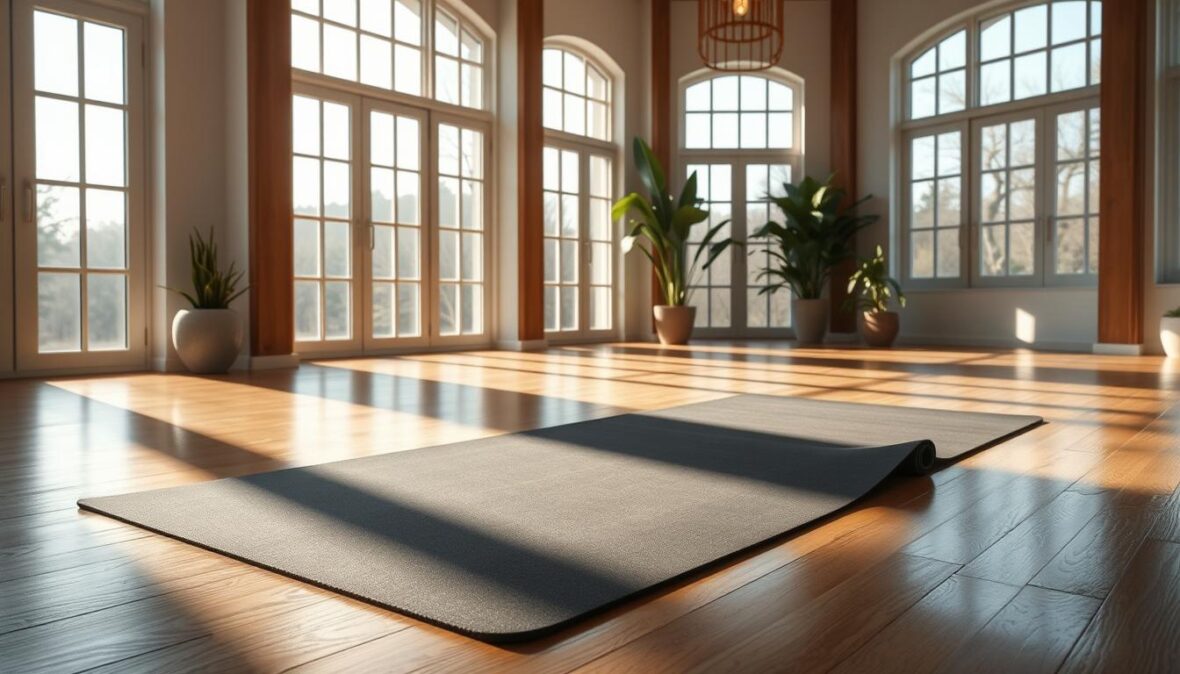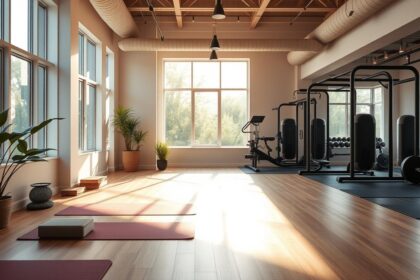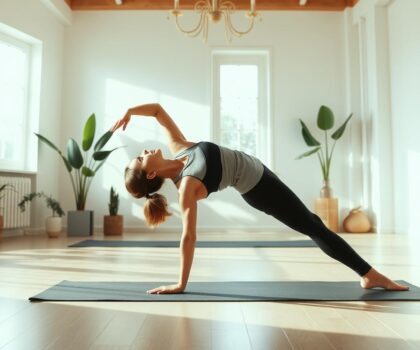Yoga lovers often wonder if a pricey yoga mat is worth it. With yoga becoming more popular, high-end mats are everywhere. But do these expensive mats really make a difference? This article looks into the best yoga mats of 2024 and how they can change your practice.
Expensive yoga mats offer better grip and eco-friendly materials. We’ll check out top brands and compare affordable mats with luxury ones. You’ll learn if spending more on a mat fits your yoga goals.
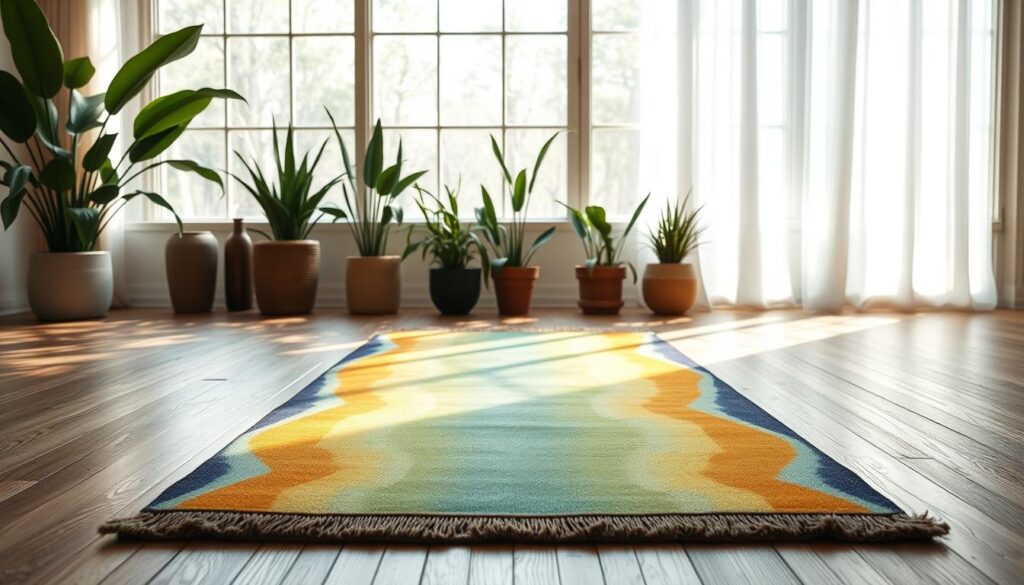
Whether you’re a pro or new to yoga, knowing the good and bad of premium mats helps. Let’s dive into the details. Do these pricey mats really live up to the expectations?
Key Takeaways
- Expensive yoga mats often offer superior grip and durability
- Premium materials can enhance comfort and support during practice
- High-end mats may provide better eco-friendly options
- The best yoga mats of 2024 balance quality and functionality
- Investment in a quality mat can potentially improve yoga performance
- Consider your practice level and frequency when choosing a mat
Understanding the Price Range of Modern Yoga Mats
Yoga mats vary in price, from affordable to high-end. The cost depends on quality, brand, and features.
Entry-Level vs Premium Yoga Mat Pricing
A basic yoga mat costs $10 to $30. These mats use simple materials and work well enough. But, a top-notch mat can cost $60 to over $200. Brands like Lululemon, Manduka, and Liforme fall into this higher price range.
What Determines Yoga Mat Costs
Several things affect a yoga mat’s price:
- Material quality
- Manufacturing process
- Durability
- Eco-friendliness
- Brand reputation
Expensive mats use better materials and advanced making methods. This means they last longer and perform better.
Market Analysis of Popular Yoga Mat Brands
Now, let’s look at some well-known yoga mat brands:
| Brand | Price Range | Key Features |
|---|---|---|
| Lululemon | $70 – $140 | Antimicrobial, reversible |
| Manduka | $45 – $150 | Lifetime guarantee, eco-friendly |
| Liforme | $140 – $180 | Alignment system, biodegradable |
These brands charge more for special features, quality, and their reputation. Knowing this helps you choose between a budget-friendly mat and a more expensive one.
Why Are Yoga Mats So Expensive?
Yoga mats can be pricey, but there are good reasons behind their cost. A quality mat that will last isn’t just about the material – it’s an investment in your practice.
The yoga mat material plays a big role in the price. Natural rubber, a top choice for eco-conscious yogis, costs more than synthetic options. It offers great grip and durability, making it worth the extra dollars.
Advanced manufacturing techniques add to the expense. Brands spend a lot on research to create mats that perform well and last long. This investment shows in the final product’s price tag.
- High-grade materials like natural rubber
- Innovative manufacturing processes
- Research and development costs
- Brand reputation and marketing
Brand value also impacts the cost. Well-known yoga mat makers charge more due to their reputation for quality and durability. You’re paying for the assurance that your mat will stand up to regular use.
| Factor | Impact on Price |
|---|---|
| Natural Rubber | High |
| Manufacturing Techniques | Medium |
| R&D Costs | High |
| Brand Value | Medium to High |
While the upfront cost might seem steep, a high-quality yoga mat is an investment that pays off over time. It supports your practice, prevents injuries, and lasts for years, making it a smart choice for serious yogis.
Key Features That Justify Higher Price Points
Premium yoga mats have features that make them worth the extra cost. They are made with high-quality materials, have advanced grip technology, and are eco-friendly. Let’s look at why they cost more.
Material Quality and Durability
Top yoga mats are made with materials that last longer. They often use natural rubber or special synthetic blends. These materials can withstand a lot of use, keeping their shape and feel over time. Some mats are reversible, offering different textures for more options.
Grip Technology and Performance
Premium mats provide a stable surface for your practice. They have special textures that prevent slipping, even during hard sessions. This grip helps keep you safe and makes moving between poses smoother.
Thickness and Support Specifications
Expensive mats usually have better cushioning. They balance comfort with stability. The extra thickness helps support your joints without losing balance. This is great for people with sensitive knees or wrists.
Environmental Impact and Sustainability
Many high-end mats focus on being eco-friendly. They use materials and processes that are good for the planet. Some brands even offer mats that can biodegrade or are made from recycled materials. This appeals to yogis who care about the environment.
| Feature | Budget Mat | Premium Mat |
|---|---|---|
| Grip | Basic | Non-slip yoga technology |
| Durability | 6-12 months | 5+ years |
| Thickness | 3-4mm | 5-6mm |
| Eco-friendly | Rarely | Often |
Premium vs Budget Yoga Mats: A Detailed Comparison

Yoga lovers often struggle with the choice between a pricey yoga mat and a budget-friendly one. This guide helps you see the main differences to make a smart choice.
A budget mat usually costs less than $30, while top-of-the-line mats can be over $100. The price difference shows in quality, durability, and how well they perform. Let’s look at the key points:
| Feature | Budget Mat | Premium Mat |
|---|---|---|
| Material | PVC or basic rubber | Natural rubber, TPE, or eco-friendly materials |
| Durability | 6-12 months | 3-5 years or more |
| Grip | Basic traction | Superior non-slip surface |
| Thickness | 3-4mm | 5-6mm |
| Eco-friendliness | Limited | Often biodegradable or recyclable |
An affordable mat might look good, but it might not grip well for tough poses. Premium mats give better stability and comfort, which can enhance your practice.
Durability is key. A more expensive mat lasts longer, saving money over time. Budget mats may need to be replaced often, costing more in the long run.
Your decision depends on how often you practice, your style, and your budget. For casual use, a cheap mat works. But if you practice a lot, a premium mat is worth it for its better performance and longer life.
Top High-End Yoga Mats of 2024
Yoga lovers looking for the best gear have many premium options in 2024. Let’s dive into some top mats that are favorites among yogis.
Lululemon The Mat
Lululemon the mat is known for its great grip and ability to keep moisture away. It has a reversible design, offering two sides for different yoga styles. People love its durability and comfort during tough workouts.
Manduka PRO Series
The Manduka PRO series, like the Manduka ProLite, is famous for lasting a long time. These mats are built to last, making them a hit with serious yogis. They have a closed-cell surface that stops sweat, keeping practice clean.
Liforme Original Mat
The Liforme original yoga mat has a special alignment system. It’s made from eco-friendly materials and has a non-slip surface. It’s a top pick for those who focus on precise yoga poses. Many like its extra size for more comfort.
Jade Harmony Professional
Jade harmony mats are made from natural rubber, giving great grip and cushioning. They’re loved by those who want eco-friendly options. Their open-cell structure keeps traction, even when it’s sweaty.
| Mat | Key Feature | Best For |
|---|---|---|
| Lululemon The Mat | Reversible, Grippy | Hot Yoga |
| Manduka ProLite | Durable, Closed-cell | Long-term Use |
| Liforme Original | Alignment System | Precise Postures |
| Jade Harmony | Eco-friendly, Open-cell | Sweaty Practice |
Long-Term Value Assessment of Expensive Yoga Mats
Buying a high-quality yoga mat can change your practice. Let’s see why a more expensive mat might be a good choice in the long run.
Cost Per Use Analysis
A premium yoga mat can save you money over time. If you use it often, the cost goes down a lot. For instance, a $100 mat used 300 times a year costs only $0.33 per session.
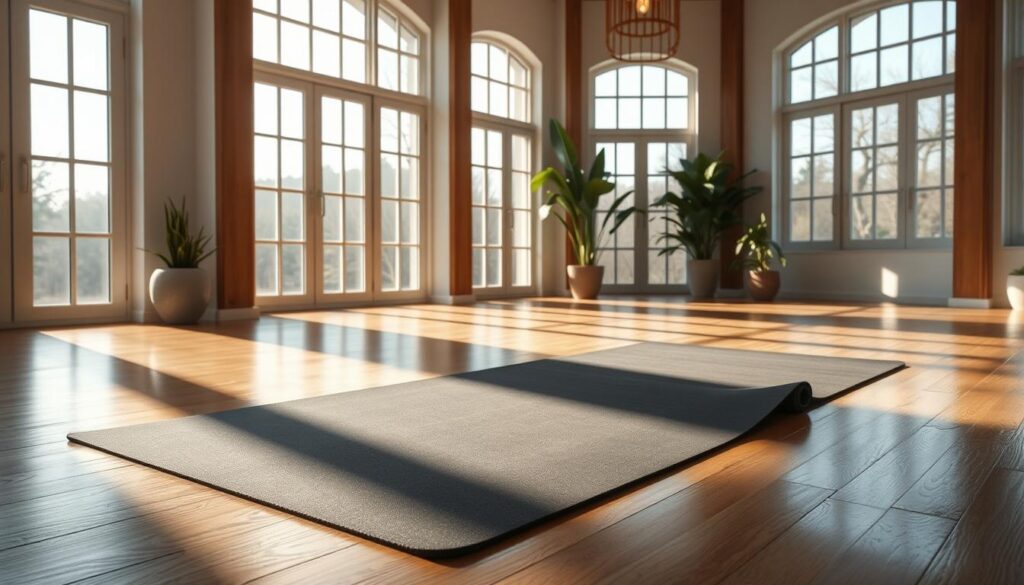
Durability and Longevity Factors
Expensive mats are made to last. They use better materials that handle sweat and friction well. This means you won’t have to replace your mat as often, making it a wise choice for yogis.
| Mat Type | Average Lifespan | Cost per Year |
|---|---|---|
| Budget Mat | 6 months | $40 |
| Premium Mat | 5+ years | $20 |
Warranty and Customer Support Consideration
High-end yoga mat brands often have great warranties and support. This protection keeps your investment safe from defects or problems. Some brands even offer lifetime guarantees, showing they believe in their product’s long life.
Considering durability, cost, and warranty, an expensive yoga mat is often a good investment for serious practitioners.
Impact of Mat Quality on Yoga Practice
A high-quality yoga mat can really improve your practice. It helps you master yoga poses and perfect your vinyasa flow. The right mat makes a big difference.
Performance Enhancement Features
Premium mats have a better grip, which is key for staying stable in tough poses like downward dog. This grip stops you from slipping. So, you can focus on your form and breathing without worrying about staying in place.
Comfort and Injury Prevention
Quality mats also offer great cushioning, which protects your joints during hard sequences. This is really helpful in hot yoga, where sweat can make the mat slippery. A well-cushioned mat helps absorb shock, easing the pressure on your knees, wrists, and ankles.
Style-Specific Mat Requirements
Each yoga style needs different mat features. For hot yoga, mats that wick away moisture are best. Vinyasa fans should look for mats with alignment markers to improve their poses. Think about your main yoga style when picking a mat to get the most out of it.
| Yoga Style | Recommended Mat Features |
|---|---|
| Hot Yoga | Moisture-wicking, extra grip |
| Vinyasa | Alignment markers, durability |
| Restorative | Extra cushioning, wider size |
Investing in a quality mat that fits your yoga style can take your practice to the next level. It boosts comfort and helps prevent injuries. Choose wisely to support your yoga journey.
Professional Perspectives: Yoga Teachers’ Recommendations
Yoga teachers offer great advice on choosing the right mat. They help you pick the best equipment for your practice. Here are some tips from experienced yoga instructors to guide you.
Many teachers stress the need for a good grip and cushioning. A veteran yoga teacher says, “A stable and comfy mat can really boost your practice.”
“Invest in a mat that matches your practice level and how often you do it. It’s not just about the cost, but finding the right support for your yoga journey.”
Students often ask their teachers for help choosing a mat. Here’s what some yoga instructors suggest:
- Find mats with good grip to avoid slipping when you sweat a lot
- Consider eco-friendly mats if you care about the planet
- Choose the right thickness based on your yoga style and how sensitive your joints are
- Go for durability if you use your mat a lot or travel with it
A poll of yoga teachers found that 80% think a good mat can make a big difference. They say better mats help students feel more confident and focused during yoga.
Care and Maintenance: Maximizing Your Mat Investment
Keeping your yoga mat clean and fresh is key to making it last. We’ll look at the best ways to clean and store your mat. Plus, we’ll share tips to extend its life.
Cleaning and Storage Best Practices
Wipe your mat with a damp cloth after each use. For a deeper clean, use a gentle mat cleaner or a homemade mix of water and mild soap. Stay away from harsh chemicals that can harm the mat.
Store your mat in a cool, dry spot, away from sunlight. Roll it with the practice side out to avoid curling edges. Use a mat bag to protect it when you travel.
Extending Mat Lifespan Tips
To extend your mat’s life:
- Rotate your mat regularly to distribute wear evenly
- Use a towel for hot yoga to reduce sweat absorption
- Avoid leaving your mat in hot cars or damp areas
- Let your mat dry completely before rolling it up
When to Replace Your Mat
Even with good care, mats eventually need to be replaced. Look out for these signs:
| Sign | Description |
|---|---|
| Visible wear | Chunks missing, bald spots, or thinning areas |
| Loss of grip | Slipping during poses, even when mat clean |
| Lingering odor | Smells that persist despite thorough cleaning |
| Flaking or peeling | Material coming off in small pieces |
An old mat showing these signs can impact your practice and hygiene. If unsure, it’s wise to get a new mat for a better yoga experience.
How to Choose Between Budget and Premium Options
Choosing between budget and premium yoga mats can be tough. Your decision depends on several factors related to your yoga journey. Let’s look at how to make the best choice for your practice.
Assessing Your Practice Level
If you’re new to yoga, a budget mat might be enough. Beginners usually do simple poses that don’t need a lot of grip or cushioning. As you get better and go to more sessions, you might want a better mat for support and durability.
Considering Usage Frequency
How often you do yoga affects your mat choice. If you go to the studio every day, a premium mat can handle it. For those who practice less often, a mid-range mat could be better. Travelers might prefer a light yoga mat that’s easy to carry.
Understanding Personal Requirements
Your personal needs are key when picking a yoga mat. Think about these:
- Sweat level: If you sweat a lot, look for mats with a better grip.
- Joint sensitivity: Thicker mats are softer for sensitive joints.
- Eco-conscious: Some premium mats use eco-friendly materials if that’s important to you.
- Style preference: High-end mats often have more designs and colors.
The right mat makes your yoga better. Whether you pick budget or premium, choose one that fits your goals and makes you look forward to each session.
Conclusion
Getting the best yoga mat is a smart choice for serious yogis. These mats give you better grip, last longer, and feel more comfortable. Even though they cost more, they’re worth it in the long run.
Choosing between cheap and expensive mats depends on how often you practice. Beginners or those who practice less might do fine with a mid-range mat. But, if you’re serious or do tough poses, a high-end mat is a better choice.
The right mat can help avoid injuries, make you more stable, and boost your confidence. Whether it’s a Lululemon, Manduka, or Liforme mat, pick one that fits your needs. The best mat is one that supports your practice and keeps you motivated.
